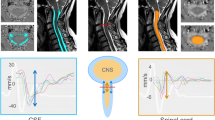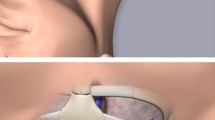Abstract
Purpose
Few studies have investigated the influence of posture on the external jugular and diploic venous systems in the head and cranial region. In this study, we aimed to investigate the effects of posture on these systems using upright computed tomography (CT) scanning.
Methods
This study retrospectively analysed an upright CT dataset from a previous prospective study. In each patient, the diameters of the vessels in three external jugular tributaries and four diploic veins were measured using CT digital subtraction venography in both supine and sitting positions.
Results
Amongst the 20 cases in the original dataset, we eventually investigated 19 cases due to motion artifacts in 1 case. Compared with the supine position, most of the external jugular tributaries collapsed, and the average size significantly decreased in the sitting position (decreased by 22–49% on average). In contrast, most of the diploic veins, except the occipital diploic veins, tended to increase or remain unchanged (increased by 12–101% on average) in size in the sitting position compared with the supine position. However, the changes in the veins associated with this positional shift were not uniform; in approximately 5–30% of the cases, depending on each vein, an opposite trend was observed.
Conclusion
Compared to the supine position, the contribution of external jugular tributaries to head venous drainage decreased in the sitting position, whilst most diploic veins maintained their contribution. These results could enhance our understanding of the physiology and pathophysiology of the head region in upright and sitting positions.





Similar content being viewed by others
Data availability
The datasets generated during and/or analyzed during the current study are not publicly available due to the limitation that the data can be viewed only in our institution but are available from the corresponding author on reasonable request with the limitation of browsing in our facility.
References
Eckenhoff JE (1971) The vertebral venous plexus. Can Anaesth Soc J 18:487–495
Manuel Valdueza J, von Münster T, Hoffman O et al (2000) Postural dependency of the cerebral venous outflow. Lancet 355:200–201
Gisolf J, van Lieshout JJ, van Heusden K et al (2004) Human cerebral venous outflow pathway depends on posture and central venous pressure. J Physiol 560:317–327
Epstein HM, Linde HW, Crampton AR et al (1970) The vertebral venous plexus as a major cerebral venous outflow tract. Anesthesiology 32:332–337
Kosugi K, Yamada Y, Yamada M et al (2020) Posture-induced changes in the vessels of the head and neck: evaluation using conventional supine CT and upright CT. Sci Rep 10:16623
Qureshi AI, Saleem MA, Naveed O et al (2017) Upright catheter-based cerebral angiography. J Vasc Interv Neurol 9:14–19
Ciuti G, Righi D, Forzoni L et al (2013) Differences between internal jugular vein and vertebral vein flow examined in real time with the use of multigate ultrasound color Doppler. AJNR Am J Neuroradiol 34:2000–2004
Jinzaki M, Yamada Y, Nagura T et al (2020) Development of upright computed tomography with area detector for whole-body scans: phantom study, efficacy on workflow, effect of gravity on human body, and potential clinical impact. Invest Radiol 55:73–83
Yamada Y, Yamada M, Yokoyama Y et al (2020) Differences in lung and lobe volumes between supine and standing positions scanned with conventional and newly developed 320-detector-row upright CT: intra-individual comparison. Respiration 99:598–605
Yamada Y, Chubachi S, Yamada M et al (2022) Comparison of lung, lobe, and airway volumes between supine and upright computed tomography and their correlation with pulmonary function test in patients with chronic obstructive pulmonary disease. Respiration 101:1110–1120
Lachkar S, Dols M-M, Ishak B et al (2019) The diploic veins: a comprehensive review with clinical applications. Cureus 11:e4422
García-González U, Cavalcanti DD, Agrawal A et al (2009) The diploic venous system: surgical anatomy and neurosurgical implications. Neurosurg Focus 27:E2
Standring S (2020) Smooth muscle and the cardiovascular and lymphatic systems. In: Gray’s Anatomy: the anatomical basis of clinical practice, 42th edn. Elsevier, Amsterdam, pp 127–144
Osborn AG (1981) Craniofacial venous plexuses: angiographic study. AJR Am J Roentgenol 136:139–143
Rusu MC, Tudose RC, Vrapciu AD, et al (2023) Anatomical variations of the external jugular vein: a pictorial and critical review. Medicina 59. https://doi.org/10.3390/medicina59030622
Hainsworth R (1990) The importance of vascular capacitance in cardiovascular control. Physiology 5:250–254
Petersen LG, Petersen JCG, Andresen M et al (2016) Postural influence on intracranial and cerebral perfusion pressure in ambulatory neurosurgical patients. Am J Physiol Regul Integr Comp Physiol 310:R100–R104
Holmlund P, Johansson E, Qvarlander S et al (2017) Human jugular vein collapse in the upright posture: implications for postural intracranial pressure regulation. Fluids Barriers CNS 14:17
San Millán Ruíz D, Gailloud P, Rüfenacht DA et al (2002) The craniocervical venous system in relation to cerebral venous drainage. AJNR Am J Neuroradiol 23:1500–1508
Gelman S (2008) Venous function and central venous pressure: a physiologic story. Anesthesiology 108:735–748
Iwabuchi T, Sobata E, Suzuki M et al (1983) Dural sinus pressure as related to neurosurgical positions. Neurosurgery 12:203–207
Marsot-Dupuch K, Gayet-Delacroix M, Elmaleh-Bergès M et al (2001) The petrosquamosal sinus: CT and MR findings of a rare emissary vein. AJNR Am J Neuroradiol 22:1186–1193
Tokuyama K, Kiyosue H, Hori Y, Nagatomi H (2020) Diploic arteriovenous fistulas with marked cortical venous reflux. Interv Neuroradiol 26:254–259
Shim J-H, Yoon S-M, Shim J-J, Kim R-S (2011) A case of intraosseous dural arteriovenous fistulas involving diploic vein treated with transarterial onyx embolization. J Korean Neurosurg Soc 50:260–263
Burger IM, Tamargo RJ, Broussard J, Gailloud P (2005) Combined surgical and endovascular treatment of a spontaneous diploic arteriovenous fistula. Case report. J Neurosurg 103:179–181
Rivera-Lara L, Gailloud P, Nyquist P (2015) Diploic arteriovenous fistulas—classification and endovascular management. Acta Neurochir 157:1485–1488
Franklin KJ (1927) Valves in veins: an historical survey. Proc R Soc Med 21:1–33
Korthuis RJ (2011) Regulation of vascular tone in skeletal muscle. In: Skeletal Muscle Circulation. Morgan Claypool, San Rafael Chapter 3
Nakagawa Y, Tsuru M, Yada K (1974) Site and mechanism for compression of the venous system during experimental intracranial hypertension. J Neurosurg 41:427–434
Jinkins JR, Dworkin JS, Damadian RV (2005) Upright, weight-bearing, dynamic-kinetic MRI of the spine: initial results. Eur Radiol 15:1815–1825
Yokoyama Y, Yamada Y, Kosugi K et al (2021) Effect of gravity on brain structure as indicated on upright computed tomography. Sci Rep 11:392
Narita K, Yamada Y, Yamada M et al (2020) Pelvic floor morphology in the standing position using upright computed tomography: age and sex differences. Int Urogynecol J 31:2387–2393
Gilbert JW, Wheeler GR, Kreft MP et al (2008) Repeat upright positional magnetic resonance imaging for diagnosis of disorders underlying chronic noncancer lumbar pain. J Manipulative Physiol Ther 31:627–631
Gilbert JW, Wheeler GR, Lingreen RA, Johnson RR (2006) Open stand-up MRI: a new instrument for positional neuroimaging. J Spinal Disord Tech 19:151–154
Acknowledgements
The authors would like to thank Ms. Naomi Tamaki, Ms. Yoko Tauchi, and Ms. Kyoko Komatsu for their valuable assistance.
Funding
This study was supported by the Japan Society for the Promotion of Science (JSPS) KAKENHI (grant numbers JP20K08056, JP21H03799, and JP23K07214) and the Takeda Science Foundation.
Author information
Authors and Affiliations
Contributions
All authors contributed to the study’s conception, analyses, and/or design as follows: conceptualisation and writing, Katsuhiro Mizutani; data analyses, Katsuhiro Mizutani, Tsubasa Miyauchi; methodology, Yoshitake Yamada; data collection, Yoshitake Yamada, Minoru Yamada, Yoichi Yamada, Kenzo Kosugi, Keisuke Yoshida; review editing, Katsuhiro Mizutani, Yoshitake Yamada, Minoru Yamada, Yoichi Yokoyama; supervision, Yoshitake Yamada, Minoru Yamada, Takenori Akiyama, Masahiro Toda, Masahiro Jinzaki. All authors read and approved the final manuscript.
Corresponding author
Ethics declarations
Conflict of interest
Masahiro Jinzaki received a grant from Canon Medical Systems. However, the company was not involved in the design and conduct of the study; in the collection, analysis, and interpretation of the data; or in the preparation, review, and approval of the manuscript. The remaining authors have no conflicts of interest to declare.
Ethics approval
In this study, we retrospectively reviewed data collected during a previous prospective study that had been approved by the local ethics committee (No. 20180035) (UMIN-CTR: UMIN000032999). The current study was approved by the local ethics committee (No. 20221150).
Informed consent
Regarding informed consent, written consent was obtained in the previous prospective study. Given the design of the present study, the local institutional ethics committees have waived the requirement for informed consent, in accordance with the ethical standards of the 1964 Declaration of Helsinki and its subsequent amendments, for this retrospective study.
Additional information
Publisher's Note
Springer Nature remains neutral with regard to jurisdictional claims in published maps and institutional affiliations.
Rights and permissions
Springer Nature or its licensor (e.g. a society or other partner) holds exclusive rights to this article under a publishing agreement with the author(s) or other rightsholder(s); author self-archiving of the accepted manuscript version of this article is solely governed by the terms of such publishing agreement and applicable law.
About this article
Cite this article
Mizutani, K., Miyauchi, T., Yamada, Y. et al. Exploration of postural effects on the external jugular and diploic venous system using upright computed tomography scanning. Neuroradiology (2024). https://doi.org/10.1007/s00234-024-03357-4
Received:
Accepted:
Published:
DOI: https://doi.org/10.1007/s00234-024-03357-4




